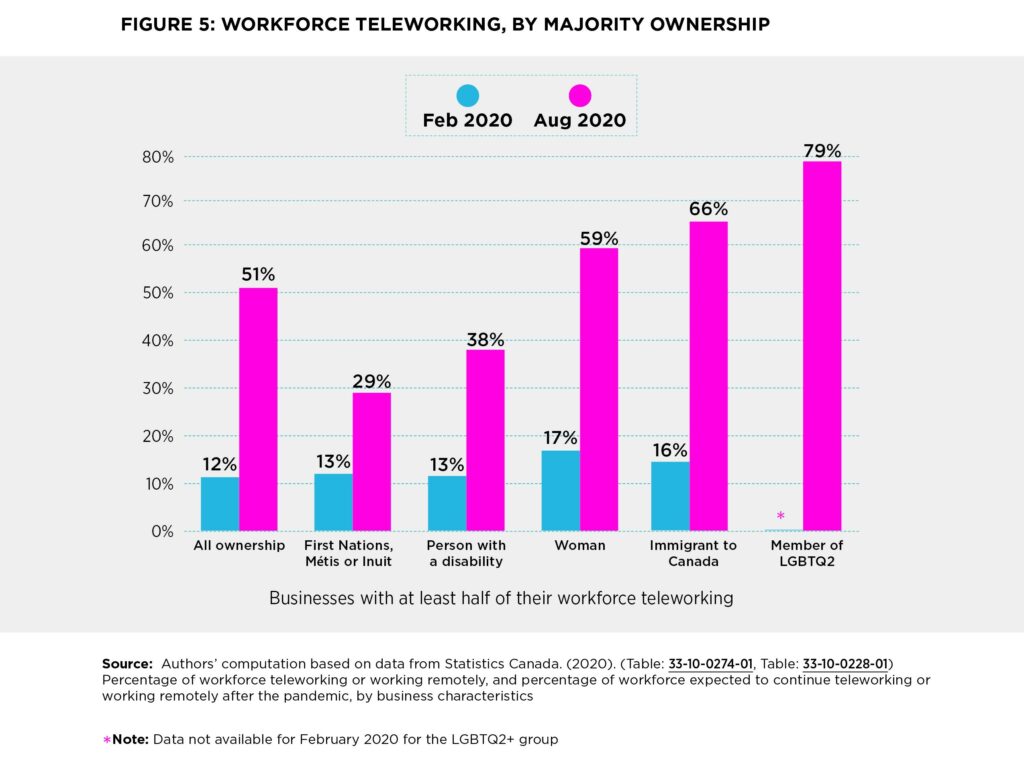
New Working Arrangements
Series | Skills for the Post-Pandemic WorldKey TakeAways
- A significant share of businesses anticipate they will continue remote work arrangements even after the pandemic is over.
- Canadians entered the pandemic era with unequal potential to telework. A person’s ability to telework varies by education level, as well as by industry and occupation; further, infrastructure requirements favour urban over rural areas. This has exacerbated existing income inequality with some people adapting quite seamlessly to new working arrangements while others have lost work opportunities as particular businesses and industries were forced to shut down, temporarily or permanently.
- While there is some discussion around ensuring worker access to necessary equipment, physical space and supporting technical infrastructure for remote work, more attention needs to be given to the skills and wrap-around supports needed to transition to and perform effectively in remote work arrangements

Executive Summary
Facing one of the most challenging health crises in a century, a large number of employers and businesses in Canada shifted to teleworking in early spring 2020. While pre-pandemic only 13 percent of workers teleworked, by the end of March 2020, four in 10 Canadian workers were teleworking. Similarly, the share of businesses that had at least half of their workforce teleworking grew to 51 percent by August 2020 from 12 percent at the beginning of February.
This report explores teleworking as a new work arrangement in Canada. We discuss the prevalence of teleworking, how workers and managers are adjusting to the rapid shift, and the inequalities in access and capacities to telework. These discussions are used to identify and highlight the skills development needed to transition to effective remote work arrangements in Canada.
Compared to past years, many Canadians are teleworking during the pandemic, with more than one-quarter reporting that they have done so throughout 2020. The highest rate was reported spring 2020, when four out of 10 workers teleworked. The prevalence of teleworking has been highest in Ontario and Quebec and lowest in Nunavut. Although there was some difference between these regions pre-pandemic, it grew dramatically during the pandemic, and Quebec experienced the greatest increase in prevalence of teleworking.
In spite of the rapid transition to teleworking and the unprecedented nature of the pandemic, the majority of workers are satisfied with their teleworking experience. Results from surveys of teleworkers show that satisfaction increased the longer workers teleworked. Conditions that led to better adjustment in teleworking include:
- good conditions for teleworking at home;
- satisfactory access to professional tools;
- being comfortable in one’s information and communications technology (ICT) skills; and
- receiving support from employers.
However, social isolation due to teleworking was found to be negatively associated with indicators measuring adjustment to teleworking.
A significant share of workers, as well as employers, indicate an interest to continue teleworking arrangements post-pandemic. Over half of workers express interest in teleworking if given the choice. Similarly, 30 percent of businesses anticipate they will allow at least half of their workforce to telework after the pandemic.
There is, however, inequality in access and ability to telework in Canada. Workers in knowledge-intensive industries are more likely to engage in remote work than those in service industries. And those with a higher level of education are more likely to telework than those with secondary-level education or lower. Rural residents are less likely than urban residents to telework. Overall, the overlapping barriers to teleworking resulted in poorer workers having less ability to telework.

Given that the ability to telework is strongly tied to workers’ job security during the pandemic, it has both employment and income inequality implications. Teleworking seems to favour women and immigrants. Proportionally more women than men and more immigrants than those born in Canada shifted to teleworking during the lockdown. On the other hand, Indigenous Peoples and persons with disabilities are lagging in transitioning to remote work. Canadians also face different levels of access to broadband internet, which will influence teleworking capacity in coming years. While 86 percent of households have access to the recommended level of internet speed, this rate falls to 40 percent in rural areas and 30 percent among First Nation communities.
Although the extent is not yet known, it is evident that significantly more Canadians will be teleworking post-pandemic relative to past years. Beyond the physical and technical infrastructure needed for teleworking, a broad spectrum of skills is also required to ensure workers can telecommute adequately.
We need to invest in skills development to bridge essential skills gaps and enable workers to telework effectively. Digital skills are the most urgent and basic ones required to work remotely. However, more attention also needs to be given to soft skills, time management skills, healthy work habits and emotional management to promote overall well-being of workers. For managers, management skills such as leading teams through a crisis, effective communication with a remote team, coaching and mentoring may be given more priority in this era of teleworking.
Skills development is a shared responsibility. Workers have to identify gaps in their skill sets and invest in skilling and upskilling. Organizations need to invest significantly in training their workers, both employees and managers, to safeguard their well-being and maintain productivity. Government should rapidly build on existing initiatives to make a suite of wrap-around programs available to Canadians to respond to existing and emerging skills gaps. Government can also design policies that incentivize employers and workers to invest in those skills and technology that can help them leapfrog to greater tech-enabled productivity. Service providers can play a significant role in this by providing and facilitating access to skills development programs.
Thank you to our partners
Skills for the Post-Pandemic World series is funded by the Government of Canada’s Future Skills Program
With support from












